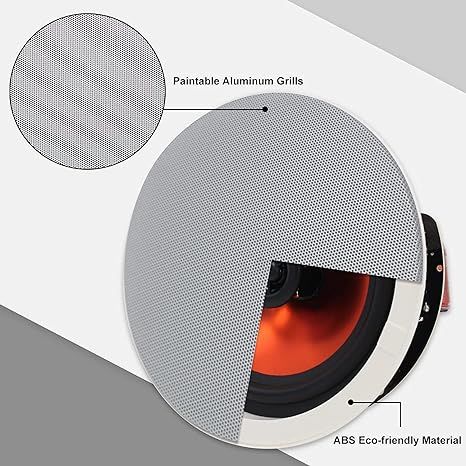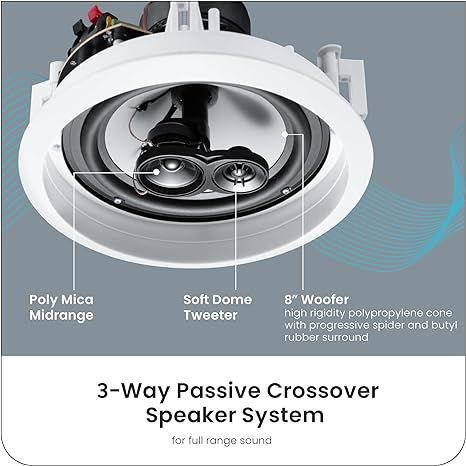Bookshelf vs. Floorstanding Speakers: Which Fits Your Room?
- What Are Bookshelf Speakers?
- Key Features of Bookshelf Speakers:
- What Are Floorstanding Speakers?
- Key Features of Floorstanding Speakers:
- Bookshelf vs. Floorstanding: Sound Quality Comparison
- Room Size and Placement Considerations
- Cost Comparison
- Aesthetics and Design
- When Bookshelf Speakers Are the Better Choice
- When Floorstanding Speakers Are the Better Choice
- Integration With Home Theater Systems
- Power and Amplifier Requirements
- Bookshelf vs. Floorstanding Speakers: Pros and Cons
- Recommendations by Room Type
- Tips for Optimizing Speaker Performance
- Conclusion
What Are Bookshelf Speakers?
Bookshelf speakers are compact, versatile speakers designed to sit on shelves, stands, or desks. Despite their small size, many models deliver impressive sound quality.
Key Features of Bookshelf Speakers:
-
Typically small to medium-sized (10"-16" tall).
-
Designed for smaller to mid-sized rooms.
-
Often paired with a subwoofer for fuller bass.
-
Flexible placement: desks, shelves, stands, or entertainment units.
| Specification | Typical Range |
|---|---|
| Height | 10" - 16" |
| Drivers | 1-2 |
| Frequency Response | 50 Hz - 20 kHz |
| Power Handling | 20 - 150 watts |
| Placement | Stands, shelves, or tables |
Best For: Apartments, small living rooms, desktop setups, or surround sound systems.
What Are Floorstanding Speakers?
Floorstanding speakers, also called tower speakers, are larger, full-range speakers designed to deliver powerful, room-filling sound without needing extra components.
Key Features of Floorstanding Speakers:
-
Tall cabinets with multiple drivers for full-spectrum sound.
-
Produce deep bass without an external subwoofer.
-
Better suited for medium to large rooms.
-
Often used in home theaters and high-fidelity stereo setups.
| Specification | Typical Range |
|---|---|
| Height | 35" - 50" |
| Drivers | 2-4+ |
| Frequency Response | 30 Hz - 20 kHz |
| Power Handling | 100 - 300 watts |
| Placement | Freestanding on the floor |
Best For: Large living rooms, home theaters, and audiophile-grade stereo setups.
Bookshelf vs. Floorstanding: Sound Quality Comparison
| Aspect | Bookshelf Speakers | Floorstanding Speakers |
|---|---|---|
| Bass Output | Limited, often needs a subwoofer | Deep, punchy bass built-in |
| Soundstage | Moderate, better with stands | Wide, immersive soundstage |
| Volume Levels | Best at moderate volumes | Handles high volumes easily |
| Driver Size | Smaller woofers and tweeters | Larger woofers, better midrange |
| Clarity | Excellent in small spaces | Superb detail at any volume |
Takeaway: If you want tight, balanced sound for a small space, bookshelf speakers are excellent. For full-range, powerful audio in large rooms, floorstanding speakers dominate.
Room Size and Placement Considerations
The size and layout of your room play a major role in speaker performance.
| Room Size | Recommended Speaker Type | Placement Strategy |
|---|---|---|
| Small (<150 sq. ft.) | Bookshelf speakers | On stands or shelves, ~2 feet from walls |
| Medium (150-300 sq. ft.) | Bookshelf + subwoofer OR compact floorstanders | Angled toward listening area |
| Large (300+ sq. ft.) | Floorstanding speakers | At least 3-4 feet from walls for optimal bass |
Pro Tip: Avoid placing speakers directly against walls; doing so can distort sound and reduce clarity.
Cost Comparison
| Cost Category | Bookshelf Speakers | Floorstanding Speakers |
|---|---|---|
| Entry-Level | $100 - $300 | $300 - $700 |
| Mid-Range | $300 - $700 | $700 - $1,500 |
| High-End | $800 - $2,000+ | $1,500 - $5,000+ |
| Subwoofer Requirement | Often needed | Usually optional |
| Best Value | Great for smaller spaces | Better long-term investment for large rooms |
Insight: Bookshelf speakers offer a more affordable way to get high-quality sound, especially when paired with a good subwoofer. Floorstanding models cost more upfront but can replace the need for additional components.
Aesthetics and Design
| Factor | Bookshelf Speakers | Floorstanding Speakers |
|---|---|---|
| Size | Compact, blends into furniture | Large, visually prominent |
| Placement Options | Shelves, stands, desks | Standalone only |
| Style Variety | Wide range of finishes | Premium finishes, modern designs |
| Room Impact | Minimal visual footprint | Makes a statement in décor |
When Bookshelf Speakers Are the Better Choice
Choose bookshelf speakers if:
-
You have a small to medium-sized room.
-
You want flexible placement and easy installation.
-
You're building a budget-friendly setup.
-
You plan to pair them with a powered subwoofer.
-
You prefer a minimalist aesthetic.
When Floorstanding Speakers Are the Better Choice
Choose floorstanding speakers if:
-
You have a large or open living area.
-
You want full-range sound without a subwoofer.
-
You're creating a home theater or audiophile system.
-
You want higher volume output and more powerful bass.
-
You prefer a showpiece design that complements your décor.
Integration With Home Theater Systems
| Speaker Role | Bookshelf Option | Floorstanding Option |
|---|---|---|
| Front Channels | Works in small rooms | Best for full-range sound |
| Surround Channels | Ideal due to compact size | Rarely used due to bulk |
| Subwoofer Dependency | Almost always required | Optional for many models |
| Immersion Level | Excellent with subwoofer support | Superior for standalone performance |
Recommendation: Use bookshelf speakers for surround channels in a 5.1 or 7.1 setup, and pair them with a high-quality subwoofer. Use floorstanding models as your front left and right channels for the richest experience.
Power and Amplifier Requirements
| Feature | Bookshelf Speakers | Floorstanding Speakers |
|---|---|---|
| Power Handling | 20-150 watts | 100-300 watts |
| Amplifier Requirement | Low to moderate power amps work well | Requires powerful amplifiers or AV receivers |
| Impedance | Typically 6-8 ohms | Typically 4-8 ohms |
| Efficiency | Often lower SPL than towers | Generally higher SPL and output levels |
If you plan to push your speakers to cinema-like levels, floorstanding models paired with a strong amplifier deliver better performance.
Bookshelf vs. Floorstanding Speakers: Pros and Cons
| Feature | Bookshelf Speakers | Floorstanding Speakers |
|---|---|---|
| Pros | Compact, affordable, versatile placement, great clarity | Full-range sound, deeper bass, immersive experience |
| Cons | Limited bass, may need subwoofer, less powerful | Larger size, higher cost, requires more floor space |
| Best For | Small rooms, budget setups, surround channels | Large rooms, premium audio, home theaters |
Recommendations by Room Type
| Room Type | Ideal Setup | Why It Works Best |
|---|---|---|
| Apartment Living Room | Bookshelf + Subwoofer | Compact size, powerful balanced sound |
| Dedicated Home Theater | Floorstanding + Center + Subwoofer | Immersive, cinema-quality experience |
| Office or Study | Bookshelf on Stands | Near-field listening, clean setup |
| Large Open Floor Plan | Floorstanding Pair | Wide soundstage, deeper bass response |
Tips for Optimizing Speaker Performance
-
Use Speaker Stands - Elevate bookshelf speakers to ear level for better clarity.
-
Add a Subwoofer - Complements bookshelf models for full-range sound.
-
Experiment With Placement - Moving speakers away from walls reduces muddiness.
-
Consider Room Acoustics - Rugs, curtains, and furniture improve sound balance.
-
Match With Quality Amplifiers - Ensure your amp or AV receiver matches speaker requirements.
Conclusion
When it comes to bookshelf vs. floorstanding speakers, the right choice depends on room size, budget, and personal preferences:
-
Choose bookshelf speakers if you want a compact, versatile, and budget-friendly solution for small to medium rooms.
-
Choose floorstanding speakers if you want powerful, full-range sound and have a larger space or a home theater setup.
For many homes, the best approach is a hybrid setup: bookshelf speakers for surround channels and floorstanding speakers for your main left and right channels. This combination provides immersive audio without compromising aesthetics or space.







